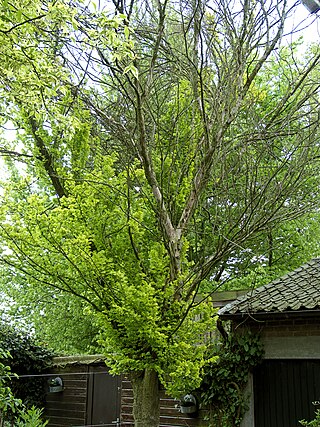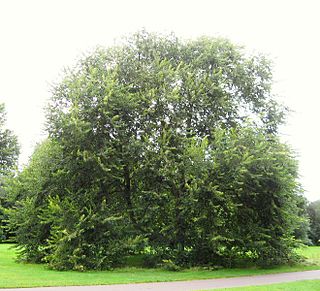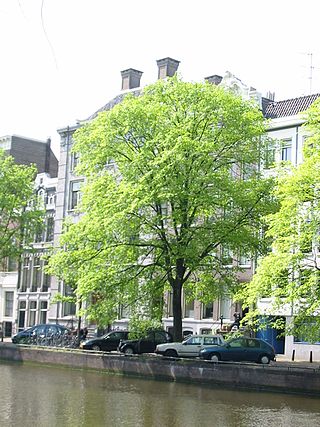
Dutch elm disease (DED) is caused by a member of the sac fungi (Ascomycota) affecting elm trees, and is spread by elm bark beetles. Believed to be originally native to Asia, the disease was accidentally introduced into America, Europe, and New Zealand. In these regions it has devastated native populations of elms that did not have resistance to the disease. The name "Dutch elm disease" refers to its identification in 1921 and later in the Netherlands by Dutch phytopathologists Bea Schwarz and Christine Buisman, who both worked with professor Johanna Westerdijk. The disease affects species in the genera Ulmus and Zelkova, therefore it is not specific to the Dutch elm hybrid.

The Wych Elm cultivar Ulmus glabra 'Camperdownii', commonly known as the Camperdown Elm, was discovered about 1835–1840 as a young contorted elm growing in the forest at Camperdown House, in Dundee, Scotland, by the Earl of Camperdown's head forester, David Taylor. The young tree was lifted and replanted within the gardens of Camperdown House where it remains to this day. The original tree, which grows on its own roots, is less than 3 m tall, with a weeping habit and contorted branch structure. The earl's gardener is said to have produced the first of what are commonly recognised as Camperdown elms by grafting a cutting to the trunk of a wych elm.

The field elm cultivar 'Atinia' , commonly known as the English elm, formerly common elm and horse may, and more lately the Atinian elm, was, before the spread of Dutch elm disease, the most common field elm in central southern England, though not native there, and one of the largest and fastest-growing deciduous trees in Europe. R. H. Richens noted that elm populations exist in north-west Spain and northern Portugal, and on the Mediterranean coast of France that "closely resemble the English elm" and appear to be "trees of long standing" in those regions rather than recent introductions. Augustine Henry had earlier noted that the supposed English elms planted extensively in the Royal Park at Aranjuez from the late 16th century onwards, specimens said to have been introduced from England by Philip II and "differing in no respects from the English elm in England", behaved as native trees in Spain. He suggested that the tree "may be a true native of Spain, indigenous in the alluvial plains of the great rivers, now almost completely deforested".

Ulmus 'Nanguen' is a complex fourth generation Dutch hybrid cultivar raised at the Dorschkamp Research Institute for Forestry & Landscape Planning, Wageningen. Lutèce was derived from the cross 'Plantyn' ×, an ancestry comprising four field elms, a wych elm, the curious Exeter Elm ('Exoniensis'), and a frost-resistant selection of the Himalayan elm.

Ulmus × hollandica 'Vegeta', sometimes known as the Huntingdon Elm, is an old English hybrid cultivar raised at Brampton, near Huntingdon, by nurserymen Wood & Ingram in 1746, allegedly from seed collected at nearby Hinchingbrooke Park. In Augustine Henry's day, in the later 19th century, the elms in Hinchingbrooke Park were U. nitens. Richens, noting that wych elm is rare in Huntingdonshire, normally flowering four to six weeks later than field elm, pointed out that unusually favourable circumstances would have had to coincide to produce such seed: "It is possible that, some time in the eighteenth century, the threefold requirements of synchronous flowering of the two species, a south-west wind", "and a mild spring permitting the ripening of the samaras, were met."

Ulmus 'New Horizon' is an American hybrid cultivar raised by the Wisconsin Alumni Research Foundation (WARF), from a crossing of the Japanese Elm clone W43-8 = 'Reseda' with Siberian Elm clone W426 grown from seed collected from a street tree at Yankton, South Dakota. As selection 'W917' it is a sibling of 'Rebona'. Tested in the US National Elm Trial coordinated by Colorado State University, 'New Horizon' averaged a survival rate of 74% after 10 years. 'New Horizon' was patented in the US in 1994, while in Europe, it is marketed as one of the 'Resista' elms protected under EU breeders' rights.

Ulmus villosa, the cherry-bark elm or Marn elm, is one of the more distinctive Asiatic elms, and a species capable of remarkable longevity. It is endemic to the valleys of the Kashmir at altitudes of 1,200–2,500 metres but has become increasingly rare owing to its popularity as cattle fodder. Mature trees are now largely restricted to temples and shrines where they are treated as sacred. Some of these trees are believed to be over 800 years old.

The Field Elm cultivar Ulmus minor 'Sarniensis', known variously as Guernsey elm, Jersey elm, Wheatley elm, or Southampton elm, was first described by MacCulloch in 1815 from trees on Guernsey, and was planted in the Royal Horticultural Society's gardens in the 1820s. It was listed in the Loddiges catalogue of 1836 as Ulmus sarniensis and by Loudon in Hortus lignosus londinensis (1838) as U. campestris var. sarniensis. The origin of the tree remains obscure; Richens believed it "a mutant of a French population of Field elm", noting that "elms of similar leaf-form occur in Cotentin and in northern Brittany. They vary much in habit but some have a tendency to pyramidal growth. Whether the distinctive habit first developed on the mainland or in Guernsey is uncertain."

The Dutch hybrid cultivar Ulmus 'Dodoens' was derived from a selfed seedling of a crossing of the Exeter Elm Ulmus 'Exoniensis' with the Himalayan Elm Ulmus wallichiana at the Dorschkamp Research Institute for Forestry & Landscape Planning, Wageningen. The tree was one of several cultivars prepared for release in 1970, but delayed by the outbreak of the second, far more aggressive strain of Dutch elm disease.

The Dutch hybrid elm cultivar Ulmus × hollandica 'Groeneveld' was cloned in 1949 at the De Dorschkamp Institute, Wageningen, and released in 1963 in response to the earlier, less virulent form of Dutch elm disease that afflicted Europe shortly after the First World War. The cultivar was derived from a crossing of Dutch clones '49', and '1', a Field Elm Ulmus minor found in central France and marketed by the Barbier nursery in Orléans.

Ulmus 'Homestead' is an American hybrid elm cultivar raised by Alden Townsend of the United States National Arboretum at the Nursery Crops Laboratory in Delaware, Ohio. The cultivar arose from a 1970 crossing of the Siberian Elm Ulmus pumila with the hybrid N 215, the latter grown from seed sent in 1960 to the University of Wisconsin-Madison elm breeding team by Hans Heybroek of the De Dorschkamp Research Institute in the Netherlands. Tested in the US National Elm Trial coordinated by Colorado State University, 'Homestead' averaged a survival rate of 85% after 10 years in the US National Elm Trial. However, planting of the tree was not recommended, owing principally to its 'ugly' shape and susceptibility to Southwest injury. 'Homestead' was released to commerce without patent restrictions in 1984.

The hybrid elm cultivar Ulmus × hollandica 'Pioneer' is an American clone arising from the crossing of two European species, Wych Elm U. glabra and Field Elm U. minor. Raised by the USDA station at Delaware, Ohio, in 1971, 'Pioneer' was released to commerce in 1983.

Ulmus 'Sapporo Autumn Gold' is one of the most commercially successful hybrid elm cultivars ever marketed, widely planted across North America and western Europe, although it has now been largely supplanted by more recent introductions. Arising from a chance crossing of the Japanese elm and Siberian elm, seed was sent in 1958 by Prof. Nobuku Takahashi and his colleagues at the Sapporo Botanical Garden of Hokkaido University, Sapporo, to Eugene Smalley at the University of Wisconsin–Madison. The patent issued in 1975 has expired, and there are now no propagation restrictions. However, the tree has proven weak-wooded on maturity, and its popularity has waned in Europe as a consequence of susceptibility to wind damage.

The hybrid elm cultivar Ulmus × hollandica 'Belgica', one of a number of hybrids arising from the crossing of Wych Elm with a variety of Field Elm, was reputedly raised in the nurseries of the Abbey of the Dunes, Veurne, in 1694. Popular throughout Belgium and the Netherlands in the 19th century both as an ornamental and as a shelter-belt tree, it was the 'Hollandse iep' in these countries, as distinct from the tree known as 'Dutch Elm' in Great Britain and Ireland since the 17th century: Ulmus × hollandica 'Major'. In Francophone Belgium it was known as orme gras de Malines.

The Davey Elm, Ulmus × hollandica 'Daveyi', is an English hybrid cultivar of unknown specific origin, generally restricted to the valleys of Cornwall. Its apparent south-west England provenance, along with its foliage and habit, suggest that it may be a hybrid of Wych Elm and Cornish Elm.

Ulmus 'Columella' is a Dutch elm cultivar raised by the Dorschkamp Research Institute for Forestry & Landscape Planning, Wageningen. Originally thought to have been derived from a selfed or openly pollinated seedling of the hybrid clone 'Plantyn', DNA analysis later determined it arose from a cross of 'Plantyn' and Ulmus minor. Sown in 1967, it was released for sale in 1989 after proving extremely resistant to Dutch elm disease following injection with unnaturally high doses of the pathogen, Ophiostoma novo-ulmi. However, propagated by grafting onto wych elm rootstocks, graft failure owing to incompatibility has become a common occurrence in the Netherlands.

The Field Elm cultivar Ulmus minor 'Christine Buisman' was the first cultivar released by the Dutch elm breeding programme, initiated in response to the less virulent form of Dutch elm disease (DED), Ophiostoma ulmi, which afflicted Europe's elms after the First World War. 'Christine Buisman' was selected from a batch of 390 seedlings grown from seed collected in the Parque de la Quinta de la Fuente del Berro, Madrid, by Mrs Van Eeghen, a friend of elm researcher Johanna Westerdijk, in 1929 and named for the elm disease researcher Christine Buisman. Originally identified as Ulmus foliacea, it was later treated as Ulmus × hollandica by Melville. However, more recent research in Belgium using DNA markers has reaffirmed 'Christine Buisman' as a clone of U. minor.

The elm cultivar Ulmus minor 'Bea Schwarz' was cloned at Wageningen in the Netherlands, by the elm disease committee, from a selection of Ulmus minor found in France in 1939. However, specimens of the tree grown in the UK and the United States are falsely treated as Ulmus × hollandica.

Elm yellows is a plant disease of elm trees that is spread by leafhoppers or by root grafts. Elm yellows, also known as elm phloem necrosis, is very aggressive, with no known cure. Elm yellows occurs in the eastern United States, and southern Ontario in Canada. It is caused by phytoplasmas which infect the phloem of the tree. Similar phytoplasmas, also known confusingly as 'Elm yellows', also occur in Europe. Infection and death of the phloem effectively girdles the tree and stops the flow of water and nutrients. The disease affects both wild-growing and cultivated trees.



















